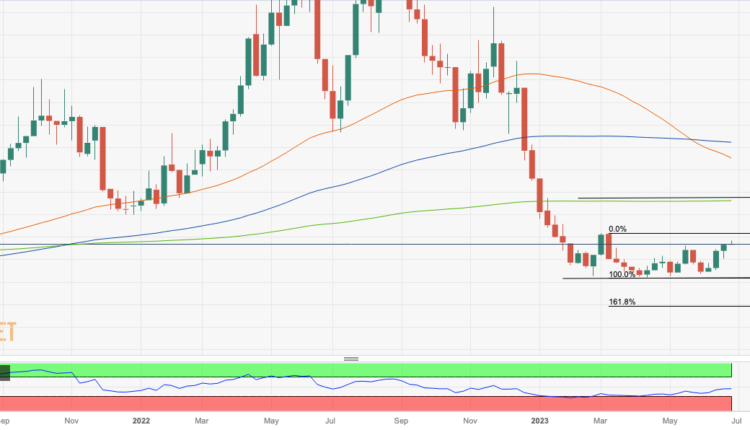Natural Gas trades flat after Russia turmoil eases
- Natural Gas price trades little changed on Tuesday after geopolitical risk surrounding Russia eases with Wagner coup U-turn.
- The summer heatwave in much of North America and Europe continues to drive demand for Natural Gas to power air conditioning.
- Price has climbed towards a significant level around $3.000 MMBtu where the longer-term downtrend could be at risk of reversing.
Natural Gas price trades flat at the start of the US Session on Tuesday after posting four consecutive days of gains. Traders had been bidding up the commodity on the back of fears political turmoil in Russia could disrupt supply, and as higher-than-average temperatures in much of the Western World increase demand for Natural Gas used in air conditioning.
XNG/USD is trading in the $2.800s MMBtu on Tuesday, during the US session.
Natural Gas news and market movers
- Natural Gas trades flat after the Wagner mutiny suddenly grinds to a halt, easing concerns Russian supply might suffer in the event of civil war, according to CNN.
- Analysts also believe the market is pricing in a greater risk premium after the failed coup over the weekend.
- Demand for Natural Gas to power air conditioning continues to be high as much of the US and Europe experience hotter-than-usual temperatures for this time of year, according to Natural Gas Intelligence.
- The market may be reaching a temporary top as recent gains have been accompanied by falling participation in the Gas futures market, according to FXStreet Senior Analyst and Editor Pablo Piovano, in a report analyzing CME data on Monday.
- Norwegian supply concerns, after outages at the Hammerfest LNG export terminal and the processing plants at Nyhamna and Kollsnes, continue to underpin prices. Norway has taken over from Russia as Europe’s main source of Natural Gas.
- Weaker demand from faltering global growth, however, has offset the threat to supplies, according to an analysis by ANZ Bank cited on MarketWatch.
- Last week’s Purchasing Manager Index data was on the whole poor for most of Europe and the US, potentially indicating a weaker global economic growth trajectory.
Natural Gas Technical Analysis: Recovery nears significant trend-determination level
Natural Gas price is trading just below a key trend-determination level on longer-term charts. Although the commodity remains in a long-term downtrend since turning lower at the August 2022 peak, bearish momentum has tapered off considerably.
The Relative Strength Index (RSI) momentum indicator is converging bullishly with price on the weekly chart, something that occurs when price makes new lows but RSI does not.
A break above the last lower high of the long-term downtrend at $3.079 MMBtu would indicate a reversal in the broader downtrend.
-638234664746458842.png)
Natural Gas: Weekly Chart
Given this level has not been breached yet, however, the downtrend remains intact and a break below the $2.110 year-to-date lows would provide a confirmation of a continuation down to a target at $1.546. This target is the 61.8% Fibonacci extension of the height of the roughly sideways consolidation range that has been unfolding during 2023 (marked 161.8% on charts).
On the daily chart, price has been climbing within a roughly sideways market, although it has broken above both the 50 and not the 100-day Simple Moving Averages (SMA).
-638234665573110757.png)
Natural Gas: Daily Chart
Nevertheless, a break above the last lower high of the long-term downtrend at $3.079 MMBtu would be required to indicate a reversal in the broader trend.
Such a move might then see prices rally higher to the next key resistance level at the 200-week SMA, situated at $3.813.
Until that happens however, price will probably continue to consolidate within its range or even go lower.
Natural Gas FAQs
What fundamental factors drive the price of Natural Gas?
Supply and demand dynamics are a key factor influencing Natural Gas prices, and are themselves influenced by global economic growth, industrial activity, population growth, production levels, and inventories. The weather impacts Natural Gas prices because more Gas is used during cold winters and hot summers for heating and cooling. Competition from other energy sources impacts prices as consumers may switch to cheaper sources. Geopolitical events are factors as exemplified by the war in Ukraine. Government policies relating to extraction, transportation, and environmental issues also impact prices.
What are the main macroeconomic releases that impact on Natural Gas Prices?
The main economic release influencing Natural Gas prices is the weekly inventory bulletin from the Energy Information Administration (EIA), a US government agency that produces US gas market data. The EIA Gas bulletin usually comes out on Thursday at 14:30 GMT, a day after the EIA publishes its weekly Oil bulletin. Economic data from large consumers of Natural Gas can impact supply and demand, the largest of which include China, Germany and Japan. Natural Gas is primarily priced and traded in US Dollars, thus economic releases impacting the US Dollar are also factors.
How does the US Dollar influence Natural Gas prices?
The US Dollar is the world’s reserve currency and most commodities, including Natural Gas are priced and traded on international markets in US Dollars. As such, the value of the US Dollar is a factor in the price of Natural Gas, because if the Dollar strengthens it means less Dollars are required to buy the same volume of Gas (the price falls), and vice versa if USD strengthens.


Comments are closed.